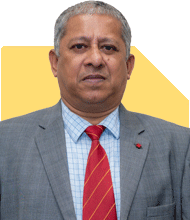Can I get any NIT/IIIT with 91%ile in JEE Mains? (General EWS, Uttar Pradesh)
Nayagam P P |10853 Answers |Ask -Follow
Career Counsellor - Answered on Feb 28, 2025
He started his career as an HR professional and has over 10 years of experience in tutoring and mentoring students from Classes 8 to 12, helping them choose the right stream, course and college/university.
He also counsels students on how to prepare for entrance exams for getting admission into reputed universities /colleges for their graduate/postgraduate courses.
He has guided both fresh graduates and experienced professionals on how to write a resume, how to prepare for job interviews and how to negotiate their salary when joining a new job.
Nayagam has published an eBook, Professional Resume Writing Without Googling.
He has a postgraduate degree in human resources from Bhartiya Vidya Bhavan, Delhi, a postgraduate diploma in labour law from Madras University, a postgraduate diploma in school counselling from Symbiosis, Pune, and a certification in child psychology from Counsel India.
He has also completed his master’s degree in career counselling from ICCC-Mindler and Counsel, India.
... more
Can I get any nit/iiits with 91%ile in jee mains . General ews category . Home state: uttar pradesh
Once the January JEE Main session results are declared, many students and JEE applicants start asking common questions about eligibility for specific institutes (NITs, IIITs, GFTIs, etc.) based on their percentile, category, preferred branch, and home state.
Providing precise admission chances for each student can be challenging. Some reputed educational websites offer ‘College Predictor’ tools where you can check possible college options based on your percentile, category, and preferences. However, for a more accurate understanding, here’s a simple yet effective 9-step method using JoSAA’s past-year opening and closing ranks. This approach gives you a fair estimate (though not 100% exact) of your admission chances based on the previous year’s data.
Step-by-Step Guide to Check Your Admission Chances Using JoSAA Data
Step 1: Collect Your Key Details
Before starting, note down the following details:
Your JEE Main percentile
Your category (General-Open, SC, ST, OBC-NCL, EWS, PwD categories)
Preferred institute types (NIT, IIIT, GFTI)
Preferred locations (or if you're open to any location in India)
List of at least 3 preferred academic programs (branches) as backups (instead of relying on just one option)
Step 2: Access JoSAA’s Official Opening & Closing Ranks
Go to Google and type: JoSAA Opening & Closing Ranks 2024
Click on the first search result (official JoSAA website).
You will land directly on JoSAA’s portal, where you can enter your details to check past-year cutoffs.
Step 3: Select the Round Number
JoSAA conducts five rounds of counseling.
For a safer estimate, choose Round 4, as most admissions are settled by this round.
Step 4: Choose the Institute Type
Select NIT, IIIT, or GFTI, depending on your preference.
If you are open to all types of institutes, check them one by one instead of selecting all at once.
Step 5: Select the Institute Name (Based on Location)
It is recommended to check institutes one by one, based on your preferred locations.
Avoid selecting ‘ALL’ at once, as it may create confusion.
Step 6: Select Your Preferred Academic Program (Branch)
Enter the branches you are interested in, one at a time, in your preferred order.
Step 7: Submit and Analyze Results
After selecting the relevant details, click the ‘SUBMIT’ button.
The system will display Opening & Closing Ranks of the selected institute and branch for different categories.
Step 8: Note Down the Opening & Closing Ranks
Maintain a notebook or diary to record the Opening & Closing Ranks for each institute and branch you are interested in.
This will serve as a quick reference during JoSAA counseling.
Step 9: Adjust Your Expectations on a Safer Side
Since Opening & Closing Ranks fluctuate slightly each year, always adjust the numbers for safety.
Example Calculation:
If the Opening & Closing Ranks for NIT Delhi | Mechanical Engineering | OPEN Category show 8622 & 26186 (for Home State), consider adjusting them to 8300 & 23000 (on a safer side).
If the Female Category rank is 34334 & 36212, adjust it to 31000 & 33000.
Follow this approach for Other State candidates and different categories.
Pro Tip: Adjust your expected rank slightly lower than the previous year's cutoffs for realistic expectations during JoSAA counseling.
Can This Method Be Used for JEE April & JEE Advanced?
Yes! You can repeat the same steps after your April JEE Main results to refine your admission possibilities.
You can also follow a similar process for JEE Advanced cutoffs when applying for IITs.
Want to Learn More About JoSAA Counseling?
If you want detailed insights on JoSAA counseling, engineering entrance exams, and preparation strategies, check out EduJob360’s 180+ YouTube videos on this topic!
Hope this guide helps! All the best for your admissions!
Follow RediffGURUS to Know more on 'Careers | Health | Money | Relationships'.
You may like to see similar questions and answers below
Prof Suvasish Mukhopadhyay | Answer |Ask -Follow
Career Counsellor - Answered on Feb 24, 2025
Nayagam P P |10853 Answers |Ask -Follow
Career Counsellor - Answered on Feb 24, 2025
Radheshyam Zanwar |6741 Answers |Ask -Follow
MHT-CET, IIT-JEE, NEET-UG Expert - Answered on Feb 24, 2025
Mayank Chandel |2570 Answers |Ask -Follow
IIT-JEE, NEET-UG, SAT, CLAT, CA, CS Exam Expert - Answered on Dec 10, 2025
Samraat Jadhav |2503 Answers |Ask -Follow
Stock Market Expert - Answered on Dec 10, 2025
Radheshyam Zanwar |6741 Answers |Ask -Follow
MHT-CET, IIT-JEE, NEET-UG Expert - Answered on Dec 10, 2025
Ramalingam Kalirajan |10878 Answers |Ask -Follow
Mutual Funds, Financial Planning Expert - Answered on Dec 10, 2025
Ramalingam Kalirajan |10878 Answers |Ask -Follow
Mutual Funds, Financial Planning Expert - Answered on Dec 10, 2025
Samraat Jadhav |2503 Answers |Ask -Follow
Stock Market Expert - Answered on Dec 10, 2025
Samraat Jadhav |2503 Answers |Ask -Follow
Stock Market Expert - Answered on Dec 10, 2025
Samraat Jadhav |2503 Answers |Ask -Follow
Stock Market Expert - Answered on Dec 10, 2025
Shalini Singh |180 Answers |Ask -Follow
Dating Coach - Answered on Dec 10, 2025
Radheshyam Zanwar |6741 Answers |Ask -Follow
MHT-CET, IIT-JEE, NEET-UG Expert - Answered on Dec 09, 2025

























